- Home
- About
- Map
- Trips
- Bringing Boat West
- Migration West
- Solo Motorcycle Ride
- Final Family XC Trip
- Colorado Rockies
- Graduates' XC Trip
- Yosemite & Nevada
- Colorado & Utah
- Best of Utah
- Southern Loop
- Pacific Northwest
- Northern Loop
- Los Angeles to NYC
- East Coast Trips
- Martha's Vineyard
- 1 Week in Quebec
- Southeast Coast
- NH Backpacking
- Martha's Vineyard
- Canadian Maritimes
- Ocracoke Island
- Edisto Island
- First Landing '02
- Hunting Island '02
- Stowe in Winter
- Hunting Island '01
- Lake Placid
- Chesapeake
- Provincetown
- Hunting Island '00
- Acadia in Winter
- Boston Suburbs
- Niagara Falls
- First Landing '99
- Cape Hatteras
- West Coast Trips
- Burning Man
- Utah Off-Roading
- Maui
- Mojave 4WD Course
- Colorado River Rafting
- Bishop & Death Valley
- Kauai
- Yosemite Fall
- Utah Off-Road
- Lost Coast
- Yosemite Valley
- Arizona and New Mexico
- Pescadero & Capitola
- Bishop & Death Valley
- San Diego, Anza Borrego, Joshua Tree
- Carmel
- Death Valley in Fall
- Yosemite in the Fall
- Pacific Northwest
- Utah Off-Roading
- Southern CA Deserts
- Yosemite & Covid
- Lake Powell Covid
- Eastern Sierra & Covid
- Bishop & Death Valley
- Central & SE Oregon
- Mojave Road
- Eastern Sierra
- Trinity Alps
- Tuolumne Meadows
- Lake Powell Boating
- Eastern Sierra
- Yosemite Winter
- Hawaii
- 4WD Eastern Sierra
- 4WD Death Valley +
- Southern CA Deserts
- Christmas in Tahoe
- Yosemite & Pinnacles
- Totality
- Yosemite & Sierra
- Yosemite Christmas
- Yosemite, San Diego
- Yosemite & North CA
- Seattle to Sierra
- Southwest Deserts
- Yosemite & Sierra
- Pacific Northwest
- Yosemite & South CA
- Pacific Northwest
- Northern California
- Southern Alaska
- Vancouver Island
- International Trips
- Index
- Tips
- Books
- Photos/Videos
- Search
- Contact
Rhyolite, NV
Friday, May 29, 2015 - 11:00am by Lolo
0 miles and 0 hours from our last stop
Travelogue
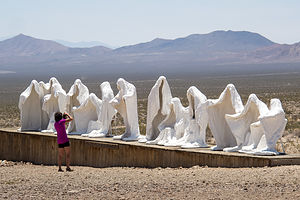 Lolo with Szukalski’s "Last Supper"Rhyolite is just 35 miles from Furnace Creek, with no big mountain passes to cross, so it’s an easy side trip from Death Valley.
Lolo with Szukalski’s "Last Supper"Rhyolite is just 35 miles from Furnace Creek, with no big mountain passes to cross, so it’s an easy side trip from Death Valley.
As I mentioned, Herb had been here about 3 weeks ago when crossing the U.S. on his motorcycle, but he thought it was worth repeating so that he could see it with me. I thought that was so sweet. He won some spousal points on that one.
We went first to the Goldwell Open Air Museum, an outdoor sculpture museum in the middle of nowhere. We’ve been to so many outdoor sculpture gardens before, but this one’s setting in a dramatic desert landscape certainly ruled out the term sculpture “garden.”
However, it was precisely this stark setting that attracted a group of Belgian artists in the 1980s to choose this location to create their art in the first place.
 Szukalski’s "Ghost Rider"There are seven monumental sculptures spread out across the landscape. My two favorites were both by Albert Szukalski, and they both involve an unusual technique he developed in which a live model is draped in plaster-soaked burlap and has to remain still until the plaster dries enough to stand on its own. I can’t even begin to imagine how uncomfortable this must have been for the models. It gets really, really hot here.
Szukalski’s "Ghost Rider"There are seven monumental sculptures spread out across the landscape. My two favorites were both by Albert Szukalski, and they both involve an unusual technique he developed in which a live model is draped in plaster-soaked burlap and has to remain still until the plaster dries enough to stand on its own. I can’t even begin to imagine how uncomfortable this must have been for the models. It gets really, really hot here.
Szukalski’s largest work is entitled “The Last Supper,” and it consists of 12 white ghostly shapes arranged as in Leonardo da Vinci’s painting of the same name. The shapes have no faces or bodies – just drapes hanging around an invisible form.
My second favorite was aptly called “Ghost Rider.” As in Szukalski’s other works, a ghostly draped figure – minus the body inside – stood beside an actual real bicycle, as if it was getting ready to go for a ride.
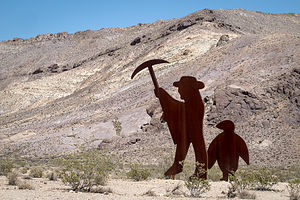 Fred Bervoets' "Tribute to Shorty"We went inside the small visitor center and chatted with the gentleman who was the caretaker of the museum. He told us that he was an artist himself and pointed out a series of 10 small paintings he had done, underneath which was the caption, “What if some favorite artists had visited the Rhyolite of today…what would they have painted? Can you recognize them all by their styles?” It would have been better if we had already been to the ghost town, because many of the scenes were taken from there, but it was really fun trying to guess what artist’s style he was trying to imitate in each of them.
Fred Bervoets' "Tribute to Shorty"We went inside the small visitor center and chatted with the gentleman who was the caretaker of the museum. He told us that he was an artist himself and pointed out a series of 10 small paintings he had done, underneath which was the caption, “What if some favorite artists had visited the Rhyolite of today…what would they have painted? Can you recognize them all by their styles?” It would have been better if we had already been to the ghost town, because many of the scenes were taken from there, but it was really fun trying to guess what artist’s style he was trying to imitate in each of them.
Herb and I are both art buffs and a bit competitive with each other, so we immediately started blurting out “Van Gogh,” “Edward Hopper,” “Grant Wood,” “Cezanne,” “Seurat,” etc., trying to beat the other to the answer. We did pretty well, if I say so myself, and declared it a tie.
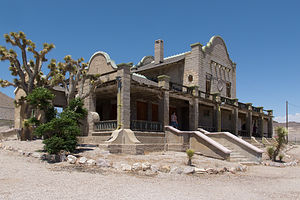 Rhyolite Train DepotA short distance up the road was the Rhyolite Ghost Town, which we had gotten a preview of in the Goldwell visitor center.
Rhyolite Train DepotA short distance up the road was the Rhyolite Ghost Town, which we had gotten a preview of in the Goldwell visitor center.
In addition to art, Herb and I love history. Having lived on the East Coast our entire lives, we know lots about Pilgrims, the Revolutionary War, Civil War battlefields, etc., but not so much about the irresistible allure of gold and how its discovery could create towns out of nothing within an instant, only to disappear just as quickly when the gold dried up.
Rhyolite is just one of many examples of that purely western phenomenon. Prior to 1904, the population of the area which became Rhyolite was about 5, consisting of Old Man Beatty and his family, who lived in a ranch about five miles away.
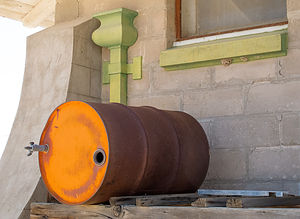 Rhyolite Train Depot DetailThen, as the story always goes, two gentlemen – one named Shorty Harris (they always seem to have cool names like Shorty) and E. L. Cross – discovered quartz covering a nearby hill. Since secrets about gold are rarely kept, word got out and thousands of gold-seekers descended on the area, settling in the sheltered desert basin that is now Rhyolite.
Rhyolite Train Depot DetailThen, as the story always goes, two gentlemen – one named Shorty Harris (they always seem to have cool names like Shorty) and E. L. Cross – discovered quartz covering a nearby hill. Since secrets about gold are rarely kept, word got out and thousands of gold-seekers descended on the area, settling in the sheltered desert basin that is now Rhyolite.
By 1908, the town’s population grew close to 5,000, and with all those people, you need the infrastructure to keep them supplied and entertained. At its height, Rhyolite had hotels, stores, a school for 250 children, an opera house, a railroad depot, an ice plant, an ice cream parlor, two electric plants, foundries and machine shops, and a hospital. Rhyolite even had a red light district which drew women from as far away as San Francisco.
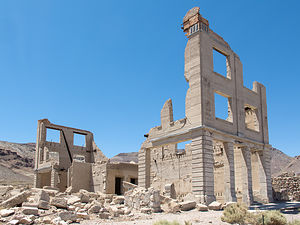 Rhyolite Cook BankRhyolite’s heyday lasted less than 10 years. The financial panic of 1907 made it more difficult to raise capital, and soon mines began to close and the banks to fail. By 1910, production had significantly slowed and there were only 611 residents left in town. In 1911, the mine and mill were closed down and by 1916 the light and power in the town were turned off.
Rhyolite Cook BankRhyolite’s heyday lasted less than 10 years. The financial panic of 1907 made it more difficult to raise capital, and soon mines began to close and the banks to fail. By 1910, production had significantly slowed and there were only 611 residents left in town. In 1911, the mine and mill were closed down and by 1916 the light and power in the town were turned off.
Today, there is not much left of this once lively and boisterous town. Not nearly as much to explore as there is at Bodie State Historic Park near Bridgeport, California, where we really got a feel for what life must have been like in one of these boom towns.
All that remains intact in Rhyolite is a beautiful, old railway depot and the Bottle House, a home made from 50,000 beer and liquor bottles. The most photographed image in Rhyolite is of the ruins of the old three-story Cook Bank. In fact, it is the most photographed ruin in the entire state of Nevada.
Rhyolite had been a very interesting stop and a good escape from the oppressive heat of Death Valley. Here it probably only hit a mere 97 degrees. Time to get back to the pool.
Description
The small town of Rhyolite is located just off Highway 394, near the eastern edge of Death Valley National Park. It is only 35 miles from the Furnace Creek Visitor Center.
For such a tiny, remote town, there are two very interesting sights, which make it a very worthwhile side trip from Death Valley:
Goldwell Open Air Museum
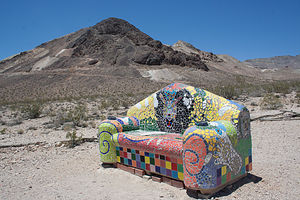 Sofie Siegmann's "Sit Here!"The Goldwell Open Air Museum is located just off State Highway 374, near the Rhyolite Ghost Town. The museum, which is open to the pubic 24 hours a day 7 days a week, has seven monumental outdoor sculptures that are colossal not only in their scale, but in their dramatic setting amongst mountains and the Mojave Desert.
Sofie Siegmann's "Sit Here!"The Goldwell Open Air Museum is located just off State Highway 374, near the Rhyolite Ghost Town. The museum, which is open to the pubic 24 hours a day 7 days a week, has seven monumental outdoor sculptures that are colossal not only in their scale, but in their dramatic setting amongst mountains and the Mojave Desert.
It was this dramatic setting that led a group of prominent Belgian artists in the 1980s to choose this location as a place to create art freely. The museum was organized in 2000 after the death of Albert Szukalski, the Belgian artist who created the site’s first sculptures. His unusual technique involved molding shapes by draping plaster-soaked burlap over live models until the plaster dried enough to stand on its own. His largest work, “The Last Supper,” consists of 12 large white ghostly shapes arranged as in da Vinci’s painting of the same name. Another one of is pieces entitled “Ghost Rider” is a plaster figure getting ready to mount a bicycle.
Today artists continue to create in this spectacular and challenging landscape as part of an art residency and workshop program.
An on-site visitor center with exhibits is open from 10:00 am to 4:00 pm, Monday through Saturday. In summer it often closes by 2:00 pm because of the heat. Admission is free.
Rhyolite Ghost Town
Like many western towns, Rhyolite sprang up from nowhere when in 1904 Shorty Harris and E. L. Cross discovered quartz on a nearby hill. Soon thousands of gold-seekers flocked to the area, settling in a sheltered desert basin which was named Rhyolite because of the silica-rich volcanic rock in the area. By 1908, the population grew close to 5,000, and the town had hotels, stores, a school for 250 children, an opera house, a railroad depot, an ice plant, two electric plants, foundries and machine shops, and a hospital. Rhyolite even had a red light district which drew women from as far away as San Francisco. One enterprising miner named Tom T. Kelly built a Bottle House, made from 50,000 beer and liquor bottles. That house is one of the buildings that still remains today.
As with so many other boom towns, Rhyolite declined as quickly as it rose. The financial panic of 1907 made it more difficult to raise capital, and soon mines began to close and the banks to fail. By 1910, production had significantly slowed and there were only 611 residents left in town. In 1911, the mine and mill were closed down and by 1916 the light and power in the town were turned off.
After 1920, Rhyolite became a tourist attraction and a setting for motion pictures. Today visitors can see several remnants of the town’s glory days: the railway depot, the Bottle House, and the ruins of the three-story Cook Bank and an old jail.
- ‹ previous
- 6 of 9
- next ›
Rhyolite location map in "high definition"
Javascript is required to view this map.
